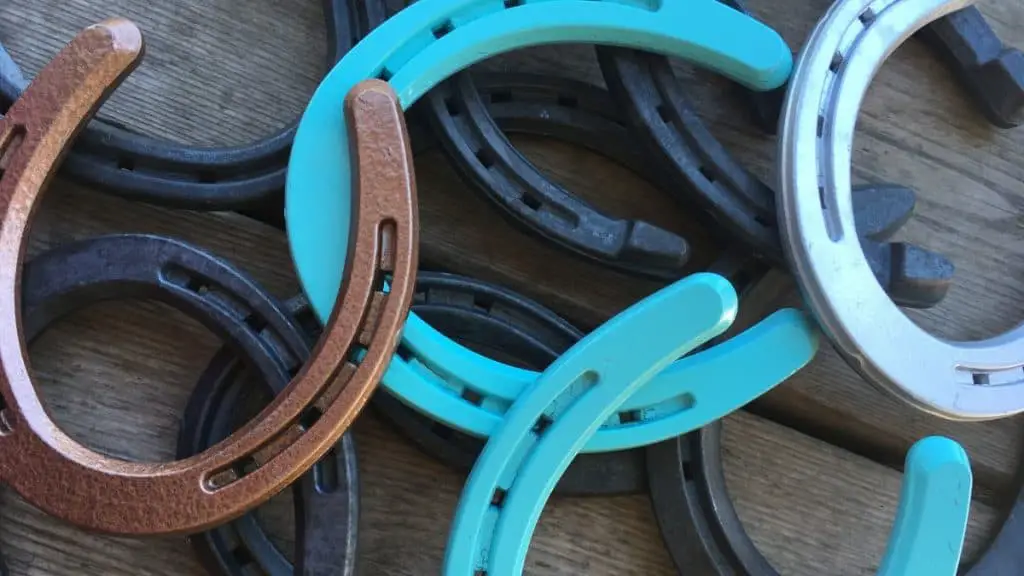Skip To Section
It’s your first day on the job as a farrier, That is, someone that shoes horses’ hooves.
Your first customer brings in a fine-looking horse and says “Hey, just fit him with keg shoes.” You go cross-eyed. You’ve never heard of keg shoes before.
What Is A Keg Horseshoe?
The American Farriers Journal defines a keg horseshoe as a horseshoe that’s been made by machine and is available in various different sizes. This contrasts to any horseshoe that might be custom-made and fit to a specific horse.

If the same rules applied to shoes for humans, just about every shoe that you would buy off the shelf would be considered a keg shoe.
Keg shoes are made with a little bit of flexibility in mind. These variations bring new names and new terms.
Different Kinds Of Keg Horseshoes
Far from being just a simple lump of metal, horseshoes have different parts. The points of a horseshoe are called the heels. A keg horseshoe with long heels is called a hot shoe. And a keg horseshoe with short heels is called a cold shoe.
Cold shoes are forged in such a fashion so that they can be adapted to either front or hind hooves.
Since the shoes aren’t tailored to any particular horse, the holes are placed so as to be as flexible as possible to whichever animal ends up wearing it.
The holes are positioned perpendicular to the shoe. Sometimes the holes are positioned closer to the outside edge of the shoe, which is termed “punched fine.” When the holes are punched closer to the inside edge of the shoe this is termed to be “punched coarse.”
Advantages
Speed of service is the biggest advantage. It costs far more time and money to have a suit tailored to you than it does to just pick a suit off the shelf at the men’s clothing store that’s the most approximate fit possible. You aren’t there very long and you don’t spend that much money.
In. Out. Done.
The suit may not fit you like a second skin the same way a tailored suit would, but you put up with those minor annoyances for the advantages.
Disadvantages
Shoes would be a simpler matter for horses if they just slipped on like human shoes.
But no. Putting shoes on a horse involves nails. If done poorly, this could cause the horse a great deal of pain.
The hooves of horses come in different shapes and sizes the same way human feet do. So there are percentages of hit and miss when it comes to using keg shoes.
If you’ve never seen the bottom of a horse’s hoof before, you might think that it’s just a solid flat surface. The bottom of the hoof is actually a very complicated thing. The heel of a horse’s hoof is designed to expand, allowing for comfort for the animal.
The last nail in a horseshoe is placed where the hoof would expand the most. So if all the nail holes in a horseshoe were used, then it would be the equivalent of a human wearing a shoe where the heel is too snug, and it would cause much discomfort over time. For this reason, the last hole is often left empty.
A hoof also has several curved and colored lines, indicating how close you are to the edge of the hoof and how close you are to where there’s the thinnest layer of unfeeling keratin before you get to the sensitive nerves of a horse’s foot.
The deal-breaker is the white line on the bottom of a horse’s hoof. Maximum fitting and comfort is had when the nails are punched into the very edge of the white line.
If the nails are too far outside the white line, it could cause splitting and chipping of the edge of the horse’s hoof, which leads to further damage later on. If the nails are too far inside the white line, then it’s pretty much like having nails driven into the bottom of your own feet. Painful.
These are the potential hazards of keg shoes. But that doesn’t mean that a keg shoe doesn’t have any room for modification.
Hot And Cold Shoeing
True or false: “Hot shoeing” means putting horseshoes with long heels on a horse, and “cold shoeing” means putting horseshoes with short heels on a horse.
The answer is false.
Hot shoeing a horse involves heating up the horseshoe in a forge so that the shoe is more malleable and can be modified. Plus it also helps that the hot metal creates an imprint on the horse’s hoof, which makes it easier to see if the shoe is going to be a good fit for the animal.
So then, cold shoeing is just what it sounds like: not heating up the Horseshoe before putting it on the horse.
Cold shoeing is quick, but it calls for a great deal of skill on the part of the farrier.
So whether you choose keg shoes or not, be sure you do business with a farrier that cares as much about the horse as they care about doing business!
